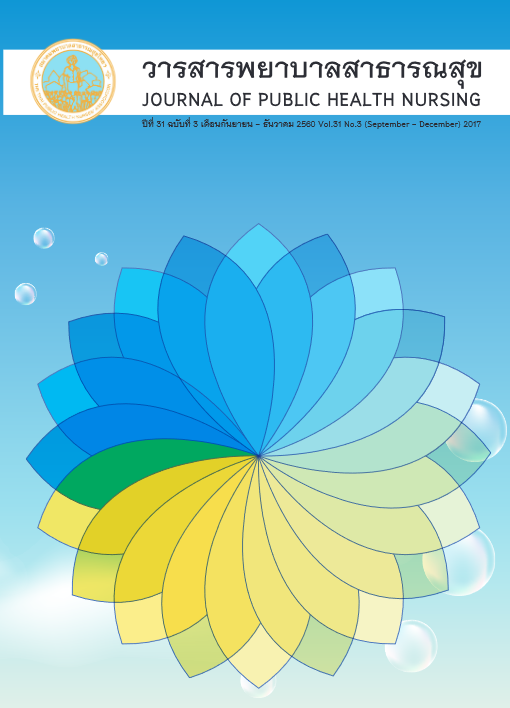Association Between Multiple Risk Behaviors and Life Assets of High School and Vocational Students
Keywords:
Multiple Risk Behaviors, Life Assets, High School Students, Vocational StudentsAbstract
Problem risk behaviors have increased, especially multiple risk behaviors. This might be due to decreasing life assets. This survey research aimed to examine the association between multiple risk behaviors and life assets among students studying in high school and vocational study in Ratchaburi Province. The sample consisted of 416 students. Multistage random sampling was conducted to draw the sample. The data were analyzed using descriptive statistics and One Way ANOVA. Level of statistically significance was p<0.05. Most (61.8%) students who had risk behaviors had only alcohol (22.6%) as their common risk behavior. Those students engaged in three risk behaviors had smoking, alcohol consumption and sexual activity behaviors (14.7%). A majority of the 416 subjects were found to have life assets at a moderate level (67.2 %). The life assets concerning the power of wisdom learning most frequently failed to meet the majority criterion (51.2%). This was followed by the power of community (50.5%), and peers and activities (35.8%) respectively. The analysis showed a significant correlation between multiple risk behaviors and life assets (F(4, 409) = 5.8, p-value<0.001). Students who had multiple risk behaviors, either two risk behaviors (alcohol consumption and sexual activity ) or three risk behaviors (smoking, alcohol consumption and sexual activity ) had lower power of self than students who had no risk behaviors (p-value<0.05). Moreover, students who had multiple risk behaviors had lower power of family and power of wisdom learning than those who had no risk behavior (p-value < 0.05). These finding suggest that life asset promoting programs are essential in the prevention of risk behaviors among high school and vocational students.
References
Suriyadeo Tripatee. Handbook for using the thai youth life assets survey youth version. National Institute for Child and Family Development. Mahidol University, 2009. (in Thai).
Suriyadeo Tripatee, Permsiri Nitimanop, PannipaSangtong, SiriwimonSalajan and SalintipChiangtong. Life assets and changing points for Thai society. National Institute for Child and Family Development. Mahidol University, 2011. (in Thai).
Arpaporn Powwattana. Health promotion and disease prevention in communities: application of concepts and theories in practice. Faculty of Public Health. Mahidol University, 2011. (in thai).
Janya Settapong, Kiatkamjorn Kuson, Saifon Ekwarangkoon and Piyatida Junpia. Risk Behaviors for the Health of Adolescents in Nakhon Sri Thammarat. Nursing and Education Journal, 2010;3 : 61. (in Thai).
Center for Alcohol Studies, Ministry of Public Health. Report on the alcohol consumption situation and impacts on the country in 2013. Available at: http://www.cas.or.th/index.php/matter/download.June 21 ,2014. (in Thai).
Center for Alcohol Studies, Thai Health Promotion Foundation. Ten outstanding situations of Alcohol Consumption and Impacts in Thailand of 2013.Ministry of Public Health, 2013. (in Thai).
Bureau of Policy and Strategy, Ministry of Public Health. Strategies, indicators and guidelines for data storage, ministry of public health, fiscal year 2014. Available at: http://203.157.181.5/yasopho/Plan2557/Template_KPI_MOP
H2557_Update.pdf. August 15,2014. (in Thai).
Lee,C et al .Situation Report and Analysis Factors Affecting Youth HIV Infection in Thailand. The School Global Studies Thummasat University, Rangsit Campus; 2014: 2-3.
Health Center 4, Ratchaburi. Report of Thai mothers and children aged under 20 years who gave birth by the Ratchaburi Office of Public Health, Fiscal Year of Work, Health Center 4, Ratchaburi, Department of Health,
Ministry of Public Health, 2013. (in Thai).
Suporn Chinaket. Factors influencing substance abuse prevention behaviors among vocational certificate studentsunder vocational education in Ratchaburi. [M.E.d.Thesis in Development Education] Nakhonpathom: Faculty of Graduate Studies, Silpakorn University, 2010. (in Thai).
Praneet Panjanetal. Project to study attitude and risk behaviors of high school students in public health districts 4 and 5.School-Aged and Youth Work, Health Center 4, Ratchaburi, Department of Health, Ministry of Public Health, 2008. (in Thai).
Ratchanee Laksitanon, Wanlee Muangsuankwan and Malee Chaimangkalo. A survey of adolescents’ opinions and sexual risk behaviors in public health districts 4 and 5. Report for 2013, Health Center 4, Ratchaburi, 2013. (in Thai).
Sucha Jan-em. Development Psychology.5thEdition. Bangkok: Thai Wattanapanit, 1999. (in Thai).
Arpaporn Powwattana. Prevention of adolescent sexual risk behaviors: participation by families, schools and communities. Faculty of Public Health, Mahidol University, 2009. (in Thai).
Kananit Sanghiran, Wanpen Kaewpan and Arpaporn Paowattana. Factors Related to Sexually-Transmitted Disease Prevention Behaviors of Female Adolescents in the Informal Education System, Bangkok Metropolitan Area.
Public Health Science Journal, Mahidol University; 2009:23. (in Thai).
United Nations Fund for Population Activities. Motherhood in Childhood Report Facing the challenge of the adolescent pregnancy. United Nations in Thailand, 2013. (in Thai).
Watcharaporn Batcharern, Panan Pitchayapinyo and Arpaporn Paowattana. Factors Related to Sexual Risk Behaviors in Junior High School Thai Students. Public Health Science Journal, Mahidol University, 2012:12:29-39. (in Thai).
Walaiporn Attanan and Unkang Saelim. Research findings on studies of behaviors and factors influencing smoking among thai youths in Bangkok. Department of Economics, Faculty of Economy, Kasetsart University, 2011. (in
Thai).
Paopong Sunthorn. Prevalence and Factors Related to Alcohol Consumption Behaviors of High School Students in Lee, Lamphun. Lanna Public Health Journal in thail, 2013:9:35-48. (in Thai).
Report on Research Findings and Referendum Survey Outcomes. Free Time Spent by Thai Adolescents. Available at: http//www.wporn.org>survey>detail. August 7, 2016. (in Thai).
Mantana Khondok, Pornnapa Homsin and Rungrat Srisuriyawet. Factors Related to Initial Alcohol Consumption in Male Junior High School Students, Bang Nam Priao, Chacherngsao. Burapha University Public Health Journal,
:7:19-32. (in Thai).
Greenberg, M.T. & Lippold, M.A. Promoting Healthy Outcomes Among Youth with Multiple Risks: Innovative Approaches. The Annual review Public Health Pennsylvania state university,2013: 34:253-70.
Downloads
Published
How to Cite
Issue
Section
License
บทความที่ตีพิมพ์และแผนภูมิรูปภาพถือเป็นลิขสิทธิ์ของวารสารพยาบาลสาธารณสุข (Thai Public Health Nurses Association)







